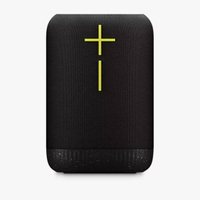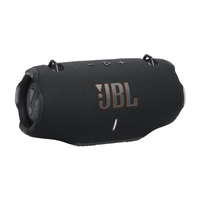The bold and assertive sound from this robust, go-anywhere wireless speaker is almost enough to make you overlook its (few, and minor) shortcomings. If you want your portable party to go with a bang, don’t look any further.
Pros
- +
Big, punchy and quite deft sound
- +
Hardy, robust construction and finish
- +
Useful two-way USB-C socket
Cons
- –
Could sound more detailed
- –
Takes forever to charge
- –
Finish attracts marks
Why you can trust TechRadar We spend hours testing every product or service we review, so you can be sure you’re buying the best. Find out more about how we test.
Bose SoundLink Max: Two-minute review
The Bose SoundLink Max has delivered the biggest, burliest model in the company’s already well-stocked and well-reviewed SoundLink concept that has served it pretty well lately. The Bose SoundLink Max has a rugged, go-anywhere design with the stamina to keep you entertained right around the clock. Well, very nearly…
It’s robust, as the IP67 rating indicates, and the liberal use of silicone means it’s happy to withstand the odd knock or bump. The carry-handle can be swapped out for a shoulder-strap (it’s a cost option, mind you), and overall the Bose SoundLink Max is as outdoors-y as they come.
And when you’re out and about, the Bose SoundLink Max is a very enjoyable companion. The sound it makes is as big and heavy as the speaker it comes from, but it’s by no means a blunt instrument. It’s quite a deft and agile listen for something with as much out-and-out punch as this, and can gesture, albeit only slightly, towards a truly stereo presentation, too.
In fact, if it were able to retrieve and reveal a little more of the fine detail in a recording, it would be approaching ‘ideal’ and one of the best Bluetooth speakers out there.
Bose Soundlink Max review: Price and release date
- Released June 4, 2024
- Officially priced at $399 / £399 / AU$599
The Bose SoundLink Max was released in early June, 2024, and sells for $399 / £399 / AU$599.
That’s proper money for a wireless speaker with no smarts and no Wi-Fi connectivity, no two ways about it. But, as will become apparent, the Bose SoundLink Max has compensations for its relative lack of functionality…
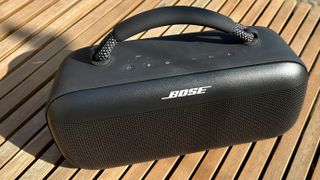
Bose SoundLink Max review: Specs
Swipe to scroll horizontally
| Weight: | 2.13kg |
| Dimensions: | 120mm (H) x 265 (W) x 105mm (D) |
| Battery life (quoted): | 20 hours |
| Connectivity: | Bluetooth 5.3 with SBC, AAC and aptX Adaptive codec |
| Drivers: | 2 x 89mm transducers, 1 x 23mm transducer, 2 x 104x79mm ‘racetrack’ passive radiators |
| Aux-in: | Yes |
| Charger port: | USB-C |
| Microphone: | No |
| Waterproof rating: | IP67 |
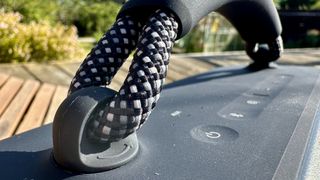
Bose SoundLink Max review: Features
- 2 x 89mm transducers, 1 x 23mm transducer, 2 x 104x79mm ‘racetrack’ passive radiators
- Bluetooth 5.3 with SBC, AAC and aptX Adaptive codec compatibility
- Class D amplification
It’s possible, of course, to use the 3.5mm analogue input to get audio information on board the Bose SoundLink Max – but obviously this is first-and-foremost a Bluetooth speaker. It uses Bluetooth 5.3 for wireless connectivity, and is compatible with SBC, AAC and aptX Adaptive codecs.
No matter how you get it there, though, once the audio information is on board it’s amplified by Class D power – Bose, as per usual, is not saying how much. Then it’s served to a speaker driver array that consists of a couple of 89mm transducers and a 23mm partner arranged across the front of the chassis, supported by a couple of 104 x 79mm ‘racetrack’ passive balanced mode radiators – there’s one at either end, behind the perforated aluminium grilles.
Thanks to Bose’s ‘SimpleSync’ technology, the SoundLink Max can quickly and easily become part of a rudimentary multiroom system, provided you’re using other compatible Bose speakers, naturally. Got a Bose soundbar or smart speaker? It’ll connect to the SoundLink Max without fuss.
There’s a USB-C on the rear of the speaker. It’s used for charging the battery, obviously, but if you’ve plenty of power on board your speaker and your phone is running low, it can also be used as a power output.
- Features score: 5/5

Bose SoundLink Max review: Design
- IP67 rating against dust and moisture
- 20 hours of battery life
- Available in two finishes
At 120 x 265 x 105mm (HxWxD) and 2.13kg, the SoundLink Max is relatively big and heavy by prevailing ‘portable wireless speaker’ standards. But thanks to a particularly judicious combination of materials – mostly aluminium and silicone and an extremely tactile, and easily swapped, rope-and-silicone carry-handle – the Bose is easy to shift from place to place. Differently coloured versions of the ‘twist-to-fit’ handle are available (for £25, roughly $31/ AU$47), and an over-the-shoulder alternative can be yours (for £45, about $58 / AU$85).
The silicone element of the design is certainly tactile, and it helps the Bose absorb bumps and shocks. But it’s very willing to collect dust and greasy fingerprints, and an absolute bugger to keep clean.
The quoted 20 hours of battery life is eminently achievable (unless you’re absolutely caning the volume), which is just as well, because to go from ‘flat’ to ‘full’ takes a leisurely five hours via the USB-C socket on the rear. On the plus side, you can be pretty sure those 20 hours can be spent in any realistic environment, thanks to a chunky IP67 rating against moisture and dust.
There are some nicely positive controls on the top of the speaker – power on/off, Bluetooth pairing, play/pause and volume up/down are all available, and there’s also a ‘shortcut’ button. In the (exemplary) Bose control app you’re able to choose between two functions for this control – either switch to the 3.5mm analogue input that’s positioned next to the USB-C, or resume Spotify playback (provided your Spotify app is up-to-date).
The app also includes some EQ adjustment along with a few presets, a volume control, connection management (the SoundLink Max can connect to two sources at a time) and a volume control. Plus, of course, access to software and firmware upgrades, voice-prompt adjustments and what have you.
- Design score: 4.5/5

Bose SoundLink Max review: Sound quality
- Punchy, full-scale sound
- Agile rather than musclebound, though
- Could conceivably sound more detailed
Bose, it seems fairly safe to say, has given low-frequency grunt and presence a proper think where the SoundLink Max is concerned. ‘It’s going to be used outdoors,’ is how I imagine the thinking going, ‘and so it needs as much punch as it’s possible to extract.’ And there’s no two ways about it, this speaker is about as robustly assertive with low-end stuff as seems possible.
It’s far from being a blunt instrument, though. Given a reasonably big file of Aphex Twin’s Isoprophlex (Slow) to deal with, the Bose hits good and hard, without question, but it controls the low end well, attacking with straight-edged positivity and ensuring bass sounds stay strictly in their lane rather than bleeding all over the midrange. This speaker hits with determination, but with accuracy, and as a consequence there’s far more to its presentation than simple muscle.
It offers quite an open, distinct midrange that’s more than capable of holding its own against all the ructions beneath it. At the top of the frequency range there’s authentic bite and shine, and just as much attack as the speaker exhibits at the opposite end – but, again, control is such that even if you listen at considerable volume (and be in no doubt, the Bose SoundLink Max is capable of considerable volume) treble sounds are never hard or in-your-face.
The Bose is tonally consistent from the top of the frequency range to the bottom, and it unites the entire range smoothly. Focus is good, too, and the SoundLink Max creates a reasonably convincing soundstage – although the notion that it’s capable of creating anything other than the tiniest hint of stereo separation is fanciful. It’s quite dynamic where the broad quiet/LOUD aspects of recordings are concerned, too, although the distance it puts between the two states could be wider. That’s almost certainly a consequence of the fact that the Bose gives every impression of playing quite loudly even when it’s playing quietly.
The most significant area where the Bose might conceivably up its game concerns detail retrieval. The SoundLink Max has no problem retaining and revealing the most significant details in a recording, but when it’s playing something like The Spark That Bled by The Flaming Lips it lets a lot of the finer details (of which this recording has plenty) go astray. It doesn’t impact on the enjoyably forceful nature of the overall presentation, of course – and if you’re listening to content for the first time it seems likely you wouldn’t even twig that anything is missing. But when you listen to stuff you’re properly familiar with, there’s no denying the Bose struggles to extract the finer detail that you know is there.
- Sound quality: 4/5
Bose SoundLink Max review: Value
Yes, pennies short of £400 / $400 / AU$600 is a lot of money for a wireless Bluetooth speaker without a hint of smart functionality. But the Bose SoundLink Max makes a very strong case for itself if you take it on its own terms – it’s properly built and finished, from materials that look good, feel good and suggest longevity.
It’s specified to perform in pretty much any realistic environment. It’s capable of big, burly and convincing sound – and can churn it out for hour after hour. So, as long as you accept its restricted functionality, the SoundLink MAx represents very good value indeed.
- Value score: 4.5/5
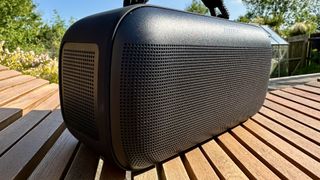
Should I buy the Bose SoundLink Max?
Swipe to scroll horizontally
| Attributes | Notes | Rating |
|---|---|---|
| Features | It’s a Bluetooth speaker with Aux-in, USB-C charging and Class D amplification – brilliant | 5/5 |
| Design | Different strap colorways (at a cost), sturdy build, positive top controls | 4.5/5 |
| Sound quality | Punchy, full-scale sound, but agile instead of muscly | 4/5 |
| Value | Costly, but the myriad features and good build are worth it | 4.5/5 |
Buy it if…
You fancy big sound no matter where you are…
The Bose SoundLink Max is capable of filling a very large space with sound – so even the great outdoors isn’t too much of a challenge.
… and you might be in dusty and/or damp conditions
An IP67 rating means the Bose is happy to travel wherever you fancy.
